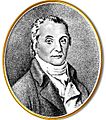Mazurek Dąbrowskiego facts for kids
Mazurek Dąbrowskiego is the official Polish national anthem. It was created in 1797 by Józef Wybicki. This song is also known as "Dąbrowski's Mazurka."
Contents
What is a National Anthem?
A national anthem is a special song that represents a country. It's often played at important events. Think of it like a musical symbol for a nation. Anthems usually talk about a country's history, struggles, or hopes. They help people feel proud of their homeland.
The Story Behind the Song
The "Mazurek Dąbrowskiego" was written a long time ago. In 1797, Poland was not a free country. Other powerful countries had taken over its land. Many Polish people wanted their country back.
Józef Wybicki wrote the song in Italy. He was with Polish soldiers called the Polish Legions. These soldiers were fighting alongside Napoleon to try and win Poland's freedom. The song was meant to give them hope and courage. It quickly became very popular among Poles who dreamed of a free Poland.
The song talks about a general named Jan Henryk Dąbrowski. He was leading the Polish Legions. The lyrics encourage the soldiers to march back to Poland. They believed that as long as they were alive, Poland could still become free again.
The Lyrics Explained
The anthem has a main part and a chorus. The chorus is repeated after each verse.
Main Part of the Song
The first lines are: Jeszcze Polska nie zginęła, Kiedy my żyjemy. This means: "Poland has not yet died, as long as we live." It's a powerful message of hope. It says that as long as Polish people are alive, their country's spirit will live on.
Co nam obca przemoc wzięła, Szablą odbierzemy. This means: "What foreign power has taken from us, we will take back with a sword." This shows the determination of the Polish people to fight for their freedom.
The Chorus
The chorus is a call to action: Marsz, marsz, Dąbrowski, Z ziemi włoskiej do Polski, Za twoim przewodem Złączym sie z narodem. This means: "March, march, Dąbrowski, from the Italian land to Poland. Under your leadership, we will unite with the nation." It's a direct command to General Dąbrowski to lead them home. It also shows the desire for all Poles to come together.
Other Verses
The song mentions crossing rivers like the Vistula and Warta. These are important rivers in Poland. It also talks about Bonaparte showing them how to win. Another verse mentions Stefan Czarniecki, a Polish general from history. He fought to save Poland before. These parts connect the current fight for freedom to past Polish victories.
The last verse is more personal. It talks about a father telling his daughter, Basia, to listen. He hears drums, hoping it means "our boys" (the Polish soldiers) are fighting. This shows how much ordinary families hoped for Poland's freedom.
Becoming the National Anthem
The "Mazurek Dąbrowskiego" was sung by Poles for many years. It was a symbol of their fight for independence. After Poland finally became a free country again in 1918, the song was officially made its national anthem in 1927.
Lyrics Table
| Mazurek Dąbrowskiego | TRANSLATION: Dąbrowski's Mazurka |
|
Jeszcze Polska nie zginęła, |
Poland has not yet succumbed. |
| Refren: Marsz, marsz, Dąbrowski, |
Chorus March! March, Dabrowski! |
|
Przejdziem Wisłę, przejdziem Wartę, |
Cross the Vistula and Warta |
| Refren:
Marsz, marsz, .... |
Chorus |
|
Jak Czarniecki do Poznania |
As Czarniecki Poznan town regains, |
| Refren:
Marsz, marsz, .... |
Chorus |
|
Już tam ojciec do swej Basi, |
And the father to Basia, |
| Refren:
Marsz, marsz, .... |
Chorus |
Images for kids
-
Bonaparte has shown us ways to victory
-
Like Czarniecki to Poznań...
-
Jan Henryk Dąbrowski (1755–1818), the general mentioned in the anthem
-
A special stone plaque in Reggio Emilia, Italy, where the song was written
-
Charles Michel Guilbert d'Anelle, Expiring Soldier of Liberty (1849). This painting shows a dying freedom fighter writing "Poland is not yet lost" in his blood.
See also
 In Spanish: Himno nacional de Polonia para niños
In Spanish: Himno nacional de Polonia para niños











